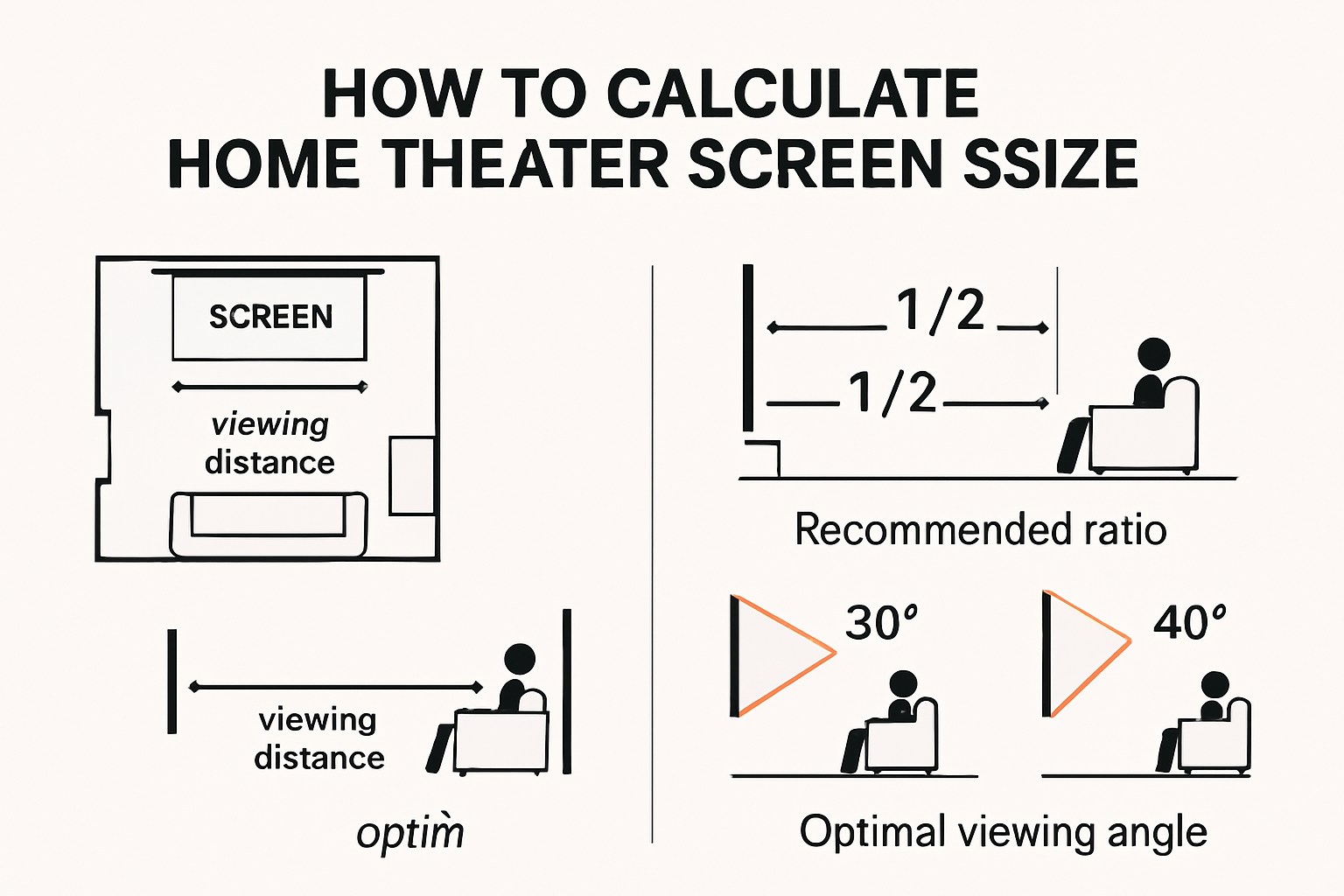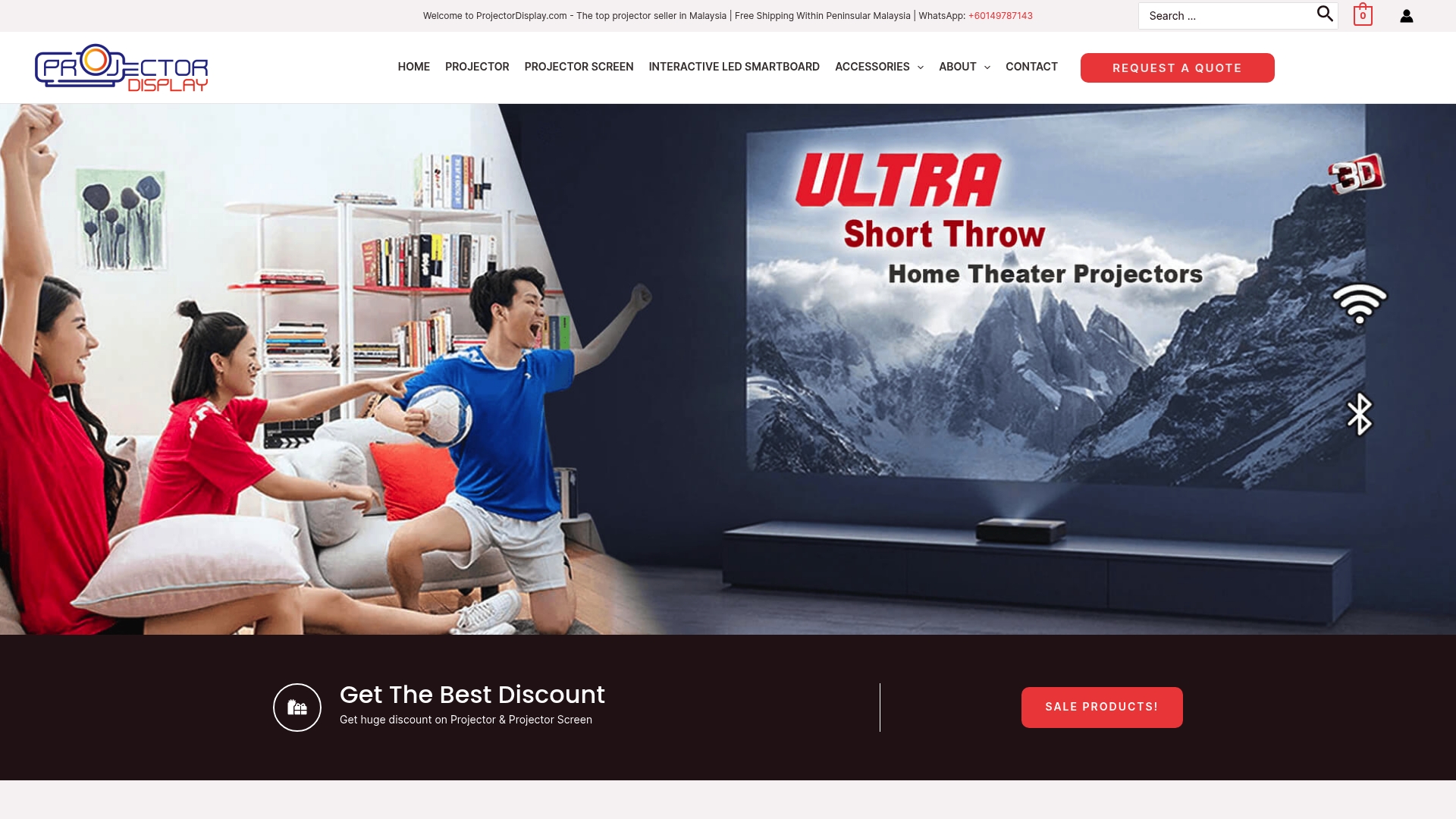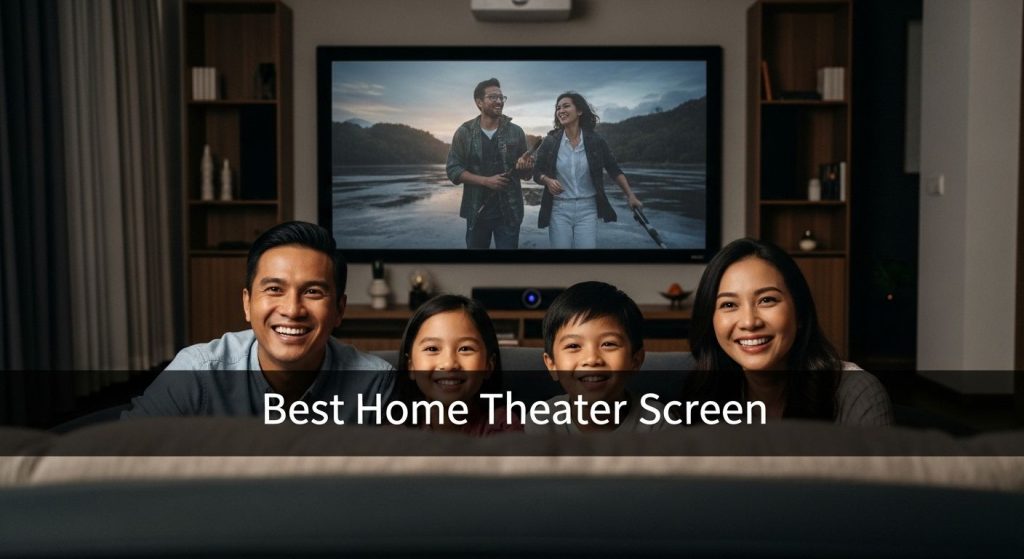Home theater screens used to mean bulky white sheets or cheap pull-down models in the corner of your living room. Today's options look nothing like that. Some of the best home theater screens now use specialized coatings that actually improve contrast by up to 20 percent over standard white screens. Most people think bigger is always better when it comes to screens, but the real secret lies in getting the material and viewing distance just right. That is where the entire movie night experience shifts from average to jaw-dropping.
Table of Contents
- Key Features Of The Best Home Theater Screen
- Choosing The Right Screen Size And Material
- Top Home Theater Screen Picks For Malaysia
- Installation Tips And Maintenance Best Practices
Quick Summary
| Takeaway | Explanation |
|---|---|
| Choose high-gain screen materials for best image quality | Opt for specialized screen surfaces that enhance light reflection and color accuracy, improving overall visual experience. |
| Calculate screen size based on viewing distance | Aim for a screen width that is 1/3 to 1/2 of the distance from the seating area to ensure comfortable viewing and immersion. |
| Consider professional installation for optimal performance | Proper alignment and mounting techniques are crucial for maintaining image quality and preventing distortion in projected visuals. |
| Use appropriate cleaning methods for screen maintenance | Protect your investment by using manufacturer-recommended cleaners and soft cloths to avoid damaging delicate screen surfaces. |
| Select screens designed for tropical environments | In humid conditions, choose materials that resist moisture and UV degradation to enhance durability and performance over time. |
Key Features of the Best Home Theater Screen
Selecting the right home theater screen goes far beyond simply picking the largest display available. Discerning home entertainment enthusiasts understand that multiple critical features determine a screen's overall performance and viewing experience.
Screen Material and Optical Properties
The fundamental backbone of any superior home theater screen is its material composition. Professional-grade screens utilize specialized materials that dramatically enhance image quality. Optical experts from DisplayTechnology.org recommend screens with high-gain white surfaces that maximize light reflection while maintaining color accuracy. These surfaces typically feature micro-textured designs that distribute projected light evenly, reducing hotspotting and ensuring consistent brightness across the entire viewing area.
White screens with gains between 1.0 and 1.3 provide the most balanced performance, offering excellent color reproduction and wide viewing angles. Some advanced screens incorporate specialized silver or gray materials that enhance contrast ratios, particularly in rooms with moderate ambient light. Research from ProjectionScreen.com indicates that gray screens can improve perceived black levels by up to 20% compared to traditional white screens.
Screen Aspect Ratio and Size Considerations
Choosing the correct screen aspect ratio is crucial for recreating a cinematic experience. While 16:9 remains the standard for most home theaters, dedicated enthusiasts might opt for 2.35:1 cinemascope screens that match professional movie theater proportions. Screen size should be carefully calculated based on viewing distance and room dimensions.
Professional AV integrators recommend a viewing distance that is approximately 1.5 to 2.5 times the screen's diagonal measurement. This ensures optimal visual immersion without causing eye strain. Screens ranging from 100 to 150 inches provide an ideal balance between immersive experience and practical room constraints for most home theater setups.
Surface Durability and Maintenance
Top-tier home theater screens are engineered for long-term performance and minimal maintenance. Advanced screens feature specialized coatings that resist dust accumulation, prevent color degradation, and maintain optical properties over extended periods. Tensioned screen surfaces ensure a perfectly flat projection area, eliminating wrinkles or distortions that could compromise image quality.
Durability markers include tear-resistant materials, UV protection to prevent color fading, and antimicrobial treatments that keep the screen surface clean. Professional projection experts recommend periodic gentle cleaning using microfiber cloths and specialized screen cleaning solutions to maintain optimal optical performance.
When searching for the best projector and screen for your home theater setup, consider these key features as your comprehensive evaluation criteria. The right screen transforms a good projection system into an extraordinary visual experience.
Choosing the Right Screen Size and Material
Selecting the optimal screen size and material represents a critical decision in creating an immersive home theater experience. This choice directly impacts image quality, viewing comfort, and overall audiovisual performance.
Understanding Screen Size Calculations
Determining the perfect screen size involves more than simply choosing the largest possible display. Projection experts from Home Theater Technology recommend calculating screen dimensions based on viewing distance and room geometry. The standard industry formula suggests that screen width should be approximately 1/3 to 1/2 of the distance between the screen and primary seating area.
For most home theater setups, screens between 100 and 150 inches provide an ideal balance. Smaller rooms might benefit from 84 to 100-inch screens, while dedicated home theater spaces can accommodate larger 200-inch displays. Research from AV Integration Monthly indicates that the optimal viewing angle should range between 30 to 40 degrees, ensuring viewers can comfortably see the entire screen without head or eye strain.

Screen Material Performance Characteristics
Screen material selection significantly influences image quality and viewing experience. Technical reviews from Home Theater HiFi reveal that different screen materials perform distinctly under varying lighting conditions. White matte screens offer excellent color neutrality and work best in controlled, dark environments. Gray screens enhance contrast in rooms with ambient light, improving black levels and perceived image depth.
To help you quickly compare the main types of screen materials and their key performance characteristics, the following table highlights how white matte, gray, and silver screens perform in various environments, based on details discussed above.
| Screen Material | Best Environment | Key Benefits | Typical Gain |
|---|---|---|---|
| White Matte | Dark, controlled rooms | Excellent color neutrality, wide viewing angles | 1.0 – 1.3 |
| Gray | Moderate ambient light | Enhanced contrast, improved black levels | 1.0 – 1.5 |
| Silver | Rooms with some light | Further boosts contrast and clarity | 1.3 – 2.0 |
| Acoustically Transparent | Dedicated theaters or multi-purpose spaces | Allows speaker placement behind screen, maintains sound quality | 0.8 – 1.1 |
Advanced screen materials incorporate specialized optical coatings that manipulate light reflection. High-gain screens (1.3 to 2.0) increase brightness in rooms with significant ambient light, while low-gain screens (0.8 to 1.0) provide more uniform light distribution. Specialized materials like micro-perforated acoustically transparent screens allow speakers to be placed directly behind the screen, creating a more immersive cinematic experience.
Durability and Long-Term Performance
Beyond immediate visual performance, screen material durability plays a crucial role in long-term satisfaction. Premium screens feature tear-resistant fabrics, UV-protective coatings, and tension systems that maintain a perfectly flat projection surface. Projection screen manufacturers recommend selecting materials with antimicrobial treatments and resistance to color degradation.
Tensioned screen systems prevent wrinkles and maintain optical precision, ensuring consistent image quality over years of use. Some advanced screens incorporate specialized edge-binding techniques that prevent fraying and maintain structural integrity. When choosing a screen, consider factors like ambient light conditions, projector brightness, and room layout.
For those seeking detailed guidance on selecting the perfect projector screen, understanding these technical nuances becomes paramount. The right screen transforms a good projection system into an extraordinary visual experience, bridging technology and cinematic immersion.
Top Home Theater Screen Picks for Malaysia
Navigating the home theater screen market requires understanding the unique requirements of Malaysian entertainment enthusiasts. Different screen types offer distinct advantages for various home environments, making selection a nuanced decision based on room characteristics, budget, and viewing preferences.
Fixed-Frame Screen Solutions
Fixed-frame screens represent the pinnacle of home theater display technology for dedicated entertainment spaces. Sound and Vision experts highlight that these screens provide a permanently stretched, tension-controlled surface that ensures optimal image quality. For Malaysian homes with dedicated media rooms, fixed-frame screens between 100-150 inches offer an immersive viewing experience.
Premium fixed-frame screens feature specialized black velvet borders that enhance contrast and reduce potential light reflection. Brands focusing on the Malaysian market typically offer screens with specialized optical coatings that perform exceptionally well in rooms with moderate ambient light. These screens range from RM 1,500 to RM 5,000, depending on size and material quality.
Acoustically Transparent and Motorized Options
For multi-purpose spaces common in Malaysian urban apartments, motorized and acoustically transparent screens provide flexible solutions. Projector Central research indicates that micro-perforated screens allow speakers to be positioned directly behind the display, creating a cinema-like sound staging. These screens are particularly beneficial for compact living spaces where traditional speaker placement might be challenging.
Motorized screens offer convenience and aesthetic flexibility. With remote-controlled mechanisms, these screens can retract seamlessly into ceiling cavities when not in use. Prices for quality motorized screens in Malaysia typically range from RM 2,000 to RM 6,000, depending on size and advanced features like integrated mounting systems and quiet motor operations.

Specialized Screens for Tropical Environments
Malaysian home theaters require screens engineered to withstand high humidity and temperature variations. Advanced screens now incorporate moisture-resistant materials and specialized coatings that prevent degradation in tropical climates. UV-protective treatments help maintain color accuracy and prevent material breakdown from intense sunlight exposure.
Gray and silver screen materials have gained popularity in Malaysian markets due to their superior performance in rooms with ambient light. These screens enhance contrast ratios and maintain image depth even when complete light control isn't possible. Projection technology experts recommend screens with gains between 1.1 and 1.5 for optimal performance in Malaysian home environments.
For those seeking comprehensive guidance on selecting the perfect home theater screen, understanding these nuanced options becomes crucial. The right screen transforms a simple projection setup into an extraordinary visual experience tailored to Malaysian homes.
Installation Tips and Maintenance Best Practices
Proper home theater screen installation and maintenance are critical for preserving image quality, ensuring longevity, and protecting your investment. Understanding the nuanced techniques and potential pitfalls can significantly enhance your audiovisual experience.
The table below summarizes the key installation and maintenance considerations for home theater screens, grouping practical tips and their benefits for long-term performance.
| Aspect | Key Consideration | Benefit |
|---|---|---|
| Installation Alignment | Use professional mounting and alignment tools | Maintains image clarity and prevents distortion |
| Tensioned Screens | Ensure proper tensioning during installation | Prevents wrinkles and preserves flatness |
| Cleaning | Use manufacturer-recommended solutions and microfiber cloths | Protects delicate coatings and prolongs screen life |
| Regular Inspection | Check mounting hardware and tension systems | Ensures stability and early detection of issues |
| Environmental Protection | Avoid direct sunlight, maintain humidity control | Prevents material degradation, mold, and fading |
Professional Installation Considerations
Home theater screen installation demands precision and technical expertise. Professional AV integrators recommend several crucial steps to guarantee optimal performance. Wall-mounted screens require careful structural assessment, ensuring mounting surfaces can support the screen's weight and withstand potential vibrations.
Precision is paramount when aligning screens. Even a slight misalignment can distort projected images, reducing overall visual quality. Specialized mounting hardware with adjustable brackets allows fine-tuning horizontal and vertical positioning. Professionals typically use laser levels and digital alignment tools to ensure screens are perfectly perpendicular to the projection axis.
For tensioned screens, professional installation becomes even more critical. Improper tension can lead to wrinkles, waves, or uneven surfaces that compromise image clarity. Projection screen manufacturers suggest professional calibration to maintain optimal surface flatness and optical performance.
Screen Cleaning and Maintenance Techniques
Maintaining a pristine screen surface requires specialized knowledge and gentle handling. AVS Forum experts emphasize the importance of using manufacturer-recommended cleaning solutions and soft, lint-free microfiber cloths. Avoid household cleaners, as harsh chemicals can damage delicate screen coatings.
Cleaning protocols vary based on screen material. White matte screens require different techniques compared to high-gain silver surfaces. Gentle, circular motions with minimal pressure help remove dust and light contamination without risking surface damage. For screens with specialized optical coatings, compressed air can effectively remove loose particles without physical contact.
Regular maintenance extends beyond surface cleaning. Inspect mounting hardware periodically for signs of stress, checking tension systems, wall mounts, and attachment points. In humid environments like Malaysia, additional attention to potential moisture-related degradation becomes crucial.
Environmental Protection and Long-Term Care
Environmental factors significantly impact home theater screen longevity. Screens in tropical climates require extra protection against humidity, temperature fluctuations, and potential UV degradation. Climate adaptation experts recommend installing screens away from direct sunlight and maintaining consistent room temperature and humidity levels.
UV-protective treatments and specialized coatings can mitigate environmental damage. Some advanced screens incorporate antimicrobial treatments that prevent mold and mildew growth in high-humidity regions. Implementing proper ventilation and using dehumidifiers can further protect screen materials from potential environmental stress.
For those seeking comprehensive maintenance guidance for home theater screens, understanding these technical nuances becomes essential. Proper care transforms a significant audiovisual investment into a long-lasting, high-performance display solution.
Frequently Asked Questions
What material is best for a home theater screen?
The best materials for home theater screens include high-gain white surfaces for maximum light reflection and color accuracy, gray materials for improved contrast in ambient light, and specialized acoustically transparent options for sound quality enhancement.
How do I determine the right screen size for my home theater?
To determine the right screen size, measure the distance from your seating area to the screen. The ideal screen width should be about 1/3 to 1/2 of that distance, ensuring a comfortable viewing experience without eye strain.
What are the differences between fixed-frame and motorized screens?
Fixed-frame screens offer a permanently tensioned surface for optimal image quality, making them ideal for dedicated media rooms. Motorized screens, on the other hand, provide flexibility and convenience, retracting into ceiling cavities when not in use, making them suitable for multi-purpose spaces.
How should I maintain my home theater screen for longevity?
To maintain your home theater screen, regularly clean it using manufacturer-recommended solutions and microfiber cloths. Inspect the mounting hardware for any wear and ensure the screen is protected from direct sunlight and humidity to prevent degradation.
Your Ultimate Home Theater Visual Upgrade Starts Here
Struggling to choose the perfect home theater screen that truly matches your space, projector, and image quality needs? You are not alone. Many homeowners face issues with washed-out colors, poor contrast, and screens that just do not last in Malaysia's tropical climate. The right screen material, size, and durable construction are every bit as important as finding a good projector. Even one small mistake can mean a blurred or disappointing movie night.
Explore our Projector Screen collection to compare top-rated models designed specifically for Malaysian homes. Discover tensioned, high-gain, and ambient-light resistant screens matched to every projector type and room size. Our expert support team is ready to guide you so you can skip the trial-and-error and get straight to jaw-dropping visuals.

Do not let your home theater experience fall short. Visit ProjectorDisplay.com now to shop, request a quote, or get personalized advice. The best viewing experience is just a click away. See the difference a professional-grade screen can make and enjoy fast shipping within Peninsular Malaysia. Act today for the clearest, most immersive visuals your home has ever seen.
Recommended
- Best Projector and Screen for Home Theater in Malaysia 2025 – Projector Display
- Projector Screen Types: Guide for Malaysia in 2025 – Projector Display
- Panduan Pilihan Projektor Home Theater Terbaik 2025 – Projector Display
- Projector Screen Size Guide 2025: Perfect Fit for Malaysian Needs – Projector Display

